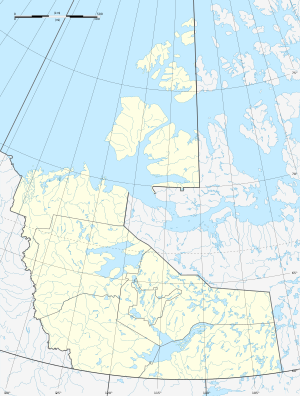Lac de Gras
| Lac de Gras | ||
|---|---|---|

|
||
| Satellite image | ||
| Geographical location | Northwest Territories (Canada) | |
| Drain | Coppermine River → Coronation Gulf ( Arctic Ocean ) | |
| Data | ||
| Coordinates | 64 ° 30 ′ N , 110 ° 30 ′ W | |
|
|
||
| Altitude above sea level | 396 m | |
| surface | 577 km² | |
| length | 60 km | |
| width | 16 km | |
| scope | 740 km | |
| Maximum depth | 56 m | |
Lac de Gras , in the language of the indigenous Ekati , is a lake in the Northwest Territories of Canada. It is located about 300 km north of Yellowknife , the capital of the territory. The Lac des Gras has a water surface of 577 km² and a total area including islands of 633 km². It has a length of 60 km and an average width of 16 km. The length of its shoreline is 740 km. The lake reaches a maximum depth of 56 m.
The following fish species live in the lake: American char , coregonus , arctic grayling , burbot , the sucking carp Catostomus catostomus and Cottus cognatus .
history
The lake was called Ekati by the indigenous people . When zinc and lead were mined in the 1960s, a dam was built to supply the mine, about which the Indian and one of the Inuit groups hunting there were not even informed. While the operating company BHP Billiton paid $ 176 million in taxes to the state and paid out $ 339 million in dividends, the indigenous people living in the area who were threatened in their existence received nothing.
Lac de Gras was the center of the Canadian diamond frenzy from 1991. Two diamond mines are in operation in the area, namely the Ekati diamond mine, which bears the original name, and the Diavik diamond mine . In 1994 discussions began between the operators and those affected, which led to various participation and compensation agreements. The caribou in the region where the largest herd lived were particularly at risk. It comprised around 350,000 animals. The negotiations became particularly difficult because the indigenous groups themselves did not have stable contracts with Canada and the Territory. In the end, the compensations were comparatively low.
The deposit Ekati is from a joint venture of the Dominion Diamond Corporation (80%) and the two geologists Chuck Fipke and Stewart Blusson (10% each) exploited the 1985 kimberlite discovered north of Lac de Gras. They discovered the Ekati deposit in 1991. The mine opened in 1998. The diamonds there are mostly located below shallow waters. Between 1998 and 2011, the mine produced more than 50 million carats of diamonds. Production should continue until at least 2019.
The Diavik mine, which was built in 2001 and opened in 2003, is located on a 20 km² island in the lake and is locally called "East Island". The deposit is located in Precambrian rocks of the Slave Geological Province , which rocks were formed 2.7 to 2.5 billion years ago. The mine produces 8 million carats or 1.6 tons of diamonds per year. It has Diavik Airport with a 1596 m long gravel runway. Diavik is a joint venture of Harry Winston Diamond Corp. and Diavik Diamond Mines Inc., a subsidiary of the Rio Tinto Group . The operating time of the Diavik mine is estimated at 16 to 22 years.
literature
- Yana Fedortchouk, Dante Canil: Intensive Variables in Kimberlite Magmas, Lac de Gras, Canada and Implications for Diamond Survival , in: Journal of Petrology 45 (2004) 1725-1745.
Individual evidence
- ^ Natural Resources Canada - The Atlas of Canada - Lakes
- ↑ Canada Yearbook 2010 , Statistics Canada, Ottawa 2010, p. 195.
- ↑ Ciaran O'Faircheallaigh: Negotiations in the Indigenous World. Aboriginal Peoples and the Extractive Industry in Australia and Canada , Routledge, 2015, Chapter 8: The Ekati diamond mine, Northwest Territories .
- ^ Mineral Atlas - Fossil Atlas , Kimberlite and Lamproite .
